Regular maintenance of beehives is crucial for ensuring the health and productivity of bee colonies. Routine inspections not only facilitate the identification of potential issues but also enhance the overall management of hive health. By implementing preventive measures against pests and diseases, beekeepers can significantly reduce the risks associated with hive maintenance. Seasonal tasks, including how to clean a beehive, play a vital role in optimizing honey production and sustaining a thriving colony. Ultimately, prioritizing regular maintenance fosters a resilient ecosystem, benefiting both the bees and the beekeeper.
Benefits of Routine Inspections
Routine inspections provide beekeepers with critical insights into hive health, population dynamics, and potential threats, ultimately fostering a more productive environment for their bees. These inspections allow for early detection of diseases and parasites, minimizing the risk of widespread infestations. By assessing the availability of food stores, beekeepers can ensure that their colonies remain well-nourished throughout the seasons. Additionally, routine checks help in monitoring the queen’s performance and overall colony productivity. Beekeepers can also evaluate the effectiveness of their management practices and make necessary adjustments. Understanding the population dynamics through inspections can inform decisions regarding hive splits or the introduction of new bees. Regular inspections enhance beekeeper confidence and knowledge, leading to better decision-making and hive management. Furthermore, they promote overall colony vitality, which contributes to higher honey yields. Ultimately, the benefits of routine inspections translate into a healthier ecosystem and sustainable beekeeping practices.
Identifying and Preventing Pests
Identifying and preventing pests is crucial for maintaining the health and productivity of a beehive. Effective pest management begins with recognizing the common threats that can compromise hive integrity, such as Varroa mites, wax moths, and small hive beetles. Regular inspections allow beekeepers to detect these pests before they can cause significant damage. Implementing integrated pest management practices, including biological controls and chemical treatments, can help mitigate these threats. Additionally, maintaining a clean and organized hive environment reduces the likelihood of infestations. Monitoring bee behavior can also provide clues about potential pest problems, as stressed bees may indicate an underlying issue. Education on pest identification and prevention strategies is essential for beekeepers at all experience levels. By prioritizing pest management, beekeepers can enhance the overall resilience of their colonies. This proactive approach lays the groundwork for effective monitoring of hive health.
Monitoring Hive Health
Monitoring hive health is essential for ensuring the well-being of the colony and maximizing honey production. Regular assessments allow beekeepers to identify signs of stress or disease early, which is crucial for effective intervention. Key indicators of hive health include the presence of a healthy queen, adequate brood patterns, and sufficient food stores. Additionally, monitoring for abnormal behaviors among the worker bees can provide insights into potential issues within the hive. Effective hive inspections should be conducted with minimal disturbance to the bees, ensuring their natural behavior remains intact. Record-keeping of inspection findings supports informed decision-making and long-term hive management strategies. Beekeepers should also remain vigilant for environmental factors that may impact hive health, such as changes in weather or the availability of forage. Addressing any concerns promptly can significantly improve the chances of maintaining a robust and productive colony. As the seasons change, it becomes increasingly important to engage in specific seasonal maintenance tasks that further support hive health.
Seasonal Maintenance Tasks
Seasonal maintenance tasks play a crucial role in ensuring the health and productivity of a beehive throughout the year. Each season presents specific challenges and opportunities that require beekeepers to adjust their management practices. In spring, hive inspections are essential to assess the queen’s health and the overall colony strength as bees prepare for nectar flow. Summer maintenance focuses on monitoring honey production and ensuring adequate ventilation to prevent overheating within the hive.
As autumn approaches, beekeepers must prepare their colonies for winter by ensuring they have sufficient food stores and implementing measures to protect against pests and diseases. Winter maintenance involves checking for adequate food reserves and ensuring the hive is properly insulated to withstand cold temperatures. Regular cleaning of equipment and removing debris helps prevent disease and promotes a healthy environment for the bees. Additionally, documenting maintenance tasks allows beekeepers to track the history of the hive and inform future management decisions. Through diligent seasonal maintenance, beekeepers can enhance the resilience and productivity of their colonies.
Enhancing Honey Production
Enhancing honey production relies heavily on optimal hive conditions and effective hive management practices. Beekeepers must ensure that hives are free from diseases and pests, as these can significantly reduce the productivity of colonies. Regular inspections help identify any potential issues early, allowing for timely interventions. Adequate space within the hive is crucial; overcrowding can lead to swarming, which negatively impacts honey yields.
Additionally, proper nutrition for bees is essential, as it directly affects their ability to produce honey. Providing supplemental feeding during times of scarcity can bolster colony health and honey production. Seasonal monitoring of nectar flow is also vital, enabling beekeepers to maximize honey extraction during peak production periods.
Moreover, maintaining hive equipment in good condition prevents contamination and promotes a more efficient honey harvest. Overall, implementing diligent management strategies fosters a thriving beehive environment conducive to enhanced honey production.
If you’re looking to diversify your investment portfolio, I highly recommend checking out the insights on thorium investment opportunities. Understanding the potential of this emerging market could be beneficial for your financial strategy. For more information, visit my webpage here.
